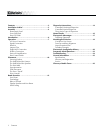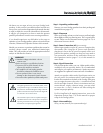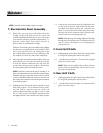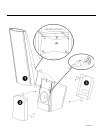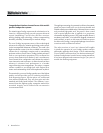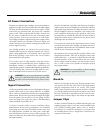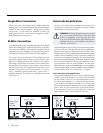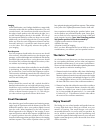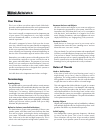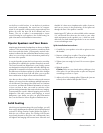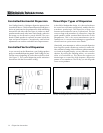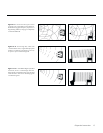
OPERATION
Operation 7
Because your MartinLogan Prodigys use an internal power
supply to energize their electrostatic cells with high-voltage
DC, they must be connected to an AC power source. For this
reason they are provided with the proper IEC standard
power cords. These cords should be firmly inserted into
the AC power receptacles on the rear connection panel
of the speakers, then to any convenient AC wall outlet.
The Prodigys integrate a signal sensing power supply which
will switch off after a few minutes of no music signal, and
requires less than two seconds to recharge the panels when
a music signal is present.
Your Prodigy speakers are wired for the power service
supplied in the country of original consumer sale. The AC
power rating applicable to a particular unit is specified
both on the packing carton and on the serial number
plate attached to the speaker.
If you remove your Prodigy speakers from the country
of original sale, be certain that AC power supplied in any
subsequent location is suitable before connecting and
operating the speakers. Substantially impaired performance
or severe damage may occur to an Prodigy speaker if oper-
ation is attempted from an incorrect AC power source.
WARNING! The power cord should not be installed,
removed, or left detached from the speaker while
the other end is connected to an AC power source.
Signal Connection
Use the best speaker cables you can. The length and type of
speaker cable used in your system will have an audible
effect. Under no circumstance should a wire of gauge higher
(thinner) than #16 be used. In general, the longer the length
used, the greater the necessity of a lower gauge, and the
lower the gauge, the better the sound, with diminishing
returns setting in around #8 to #12.
A variety of speaker cables are now available whose
manufacturers claim better performance over standard
heavy gauge wire. We have verified this in many cases, and
the improvements available are often more noticeable
than the differences between wires of different gauge. The
effects of cables may be masked if the equipment is not of
the highest quality.
We also recommend, if possible, that short runs of speaker
cable connect the power amplifier(s) and speakers and that
high quality long interconnect cables be used to connect
the preamplifier and power amplifier. This results in the
power amplifiers being close to the speakers, which may
be practically or cosmetically difficult, but if the length of
the speaker cables can be reduced to a few meters, sonic
advantages may be obtained.
Connections are done at the Signal Input section on the
rear electronics panel of the Prodigy. Use spade connectors
for optimum contact and ease of installation. Make certain
that all of your connections are tight.
Be consistent when connecting the speaker cables to the
Signal Input terminals. Take care to assign the same color
cable lead to the (+) terminal on both the left and right
channel speakers. If bass is nonexistent and you cannot
discern a tight, coherent image, you may need to reverse
the (+) and (-) leads on one speaker to bring the system
into proper polarity.
WARNING! Turn your amplifier off before making
or breaking any signal connections!
Break-In
When you first begin to play your Prodigy speakers, they
may sound a bit bass shy. This is due to the high-quality,
long-life components used in our woofer. Our custom
made, butyl surround woofer requires 30 hours of break-
in at 90 dB (moderate listening levels) before any critical
listening. The break-in requirements of the crossover com-
ponents (and, to a lesser degree, the stator) are equivalent.
Jumper Clips
In some countries federal law prohibits MartinLogan from
supplying jumper clips. If none are found installed under
your speakers binding posts, please refer to ‘Bi-Wire
Connection’ for connection instructions. If jumper clips
are installed please refer to ‘Single-Wire Connection’ for
connection instructions.
AC Power Connection




